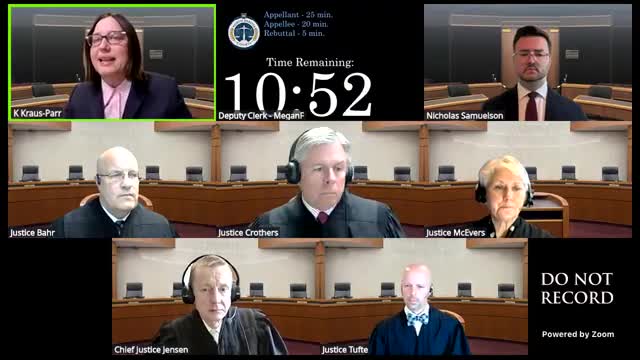Court Examines Open Carry Case Involving Mr. King and Terrorizing Charge
September 23, 2025 | Supreme Court , State Agencies, Organizations, Executive, North Dakota
This article was created by AI summarizing key points discussed. AI makes mistakes, so for full details and context, please refer to the video of the full meeting. Please report any errors so we can fix them. Report an error »

In a pivotal session at the North Dakota Supreme Court, justices grappled with the complexities of a case involving the right to bear arms and the implications of perceived threats in public spaces. The courtroom buzzed with tension as attorneys presented arguments surrounding the conviction of a man, Mr. King, charged with terrorizing after he openly carried a knife in a dimly lit parking lot.
The crux of the debate centered on whether Mr. King’s actions constituted a constitutional violation of his right to bear arms. His defense argued that the prosecution's case relied heavily on subjective interpretations of fear, suggesting that the mere presence of a weapon should not automatically lead to charges of terrorizing. They contended that if individuals could be charged simply for carrying a weapon in public, it would effectively criminalize open carry, undermining the Second Amendment rights.
As the defense attorney passionately articulated, “If it’s a gross deviation to carry a weapon in public where people can see you and possibly be frightened, then there’s literally no way to carry a weapon openly.” This statement underscored the broader implications of the case, raising questions about the balance between public safety and individual rights.
On the other side, the prosecution maintained that Mr. King’s behavior—throwing his bike down, drawing his knife, and approaching a woman in a threatening manner—went beyond mere open carry. They argued that the context of the incident, occurring early in the morning with no one else around, contributed to the perception of threat. The prosecution emphasized that the law requires not just the presence of a weapon but also intent or reckless disregard for causing fear, which they believed was evident in Mr. King’s actions.
The justices listened intently, weighing the arguments about the vagueness of the law and the standards for determining what constitutes a threat. The discussion highlighted the delicate balance courts must strike between protecting constitutional rights and ensuring public safety.
As the session drew to a close, the implications of this case loomed large. The court's decision could set a significant precedent regarding the interpretation of self-defense laws and the rights of individuals to carry weapons in public spaces. The outcome may not only affect Mr. King but could also resonate throughout North Dakota, influencing how similar cases are handled in the future. The justices are expected to deliberate carefully before issuing their ruling, which could redefine the boundaries of lawful conduct in the context of the Second Amendment.
The crux of the debate centered on whether Mr. King’s actions constituted a constitutional violation of his right to bear arms. His defense argued that the prosecution's case relied heavily on subjective interpretations of fear, suggesting that the mere presence of a weapon should not automatically lead to charges of terrorizing. They contended that if individuals could be charged simply for carrying a weapon in public, it would effectively criminalize open carry, undermining the Second Amendment rights.
As the defense attorney passionately articulated, “If it’s a gross deviation to carry a weapon in public where people can see you and possibly be frightened, then there’s literally no way to carry a weapon openly.” This statement underscored the broader implications of the case, raising questions about the balance between public safety and individual rights.
On the other side, the prosecution maintained that Mr. King’s behavior—throwing his bike down, drawing his knife, and approaching a woman in a threatening manner—went beyond mere open carry. They argued that the context of the incident, occurring early in the morning with no one else around, contributed to the perception of threat. The prosecution emphasized that the law requires not just the presence of a weapon but also intent or reckless disregard for causing fear, which they believed was evident in Mr. King’s actions.
The justices listened intently, weighing the arguments about the vagueness of the law and the standards for determining what constitutes a threat. The discussion highlighted the delicate balance courts must strike between protecting constitutional rights and ensuring public safety.
As the session drew to a close, the implications of this case loomed large. The court's decision could set a significant precedent regarding the interpretation of self-defense laws and the rights of individuals to carry weapons in public spaces. The outcome may not only affect Mr. King but could also resonate throughout North Dakota, influencing how similar cases are handled in the future. The justices are expected to deliberate carefully before issuing their ruling, which could redefine the boundaries of lawful conduct in the context of the Second Amendment.
View full meeting
This article is based on a recent meeting—watch the full video and explore the complete transcript for deeper insights into the discussion.
View full meeting
